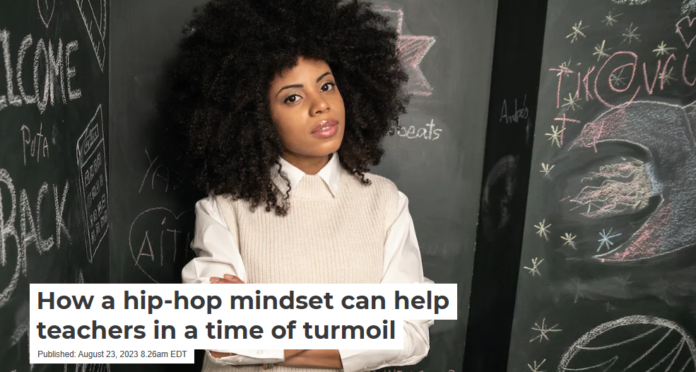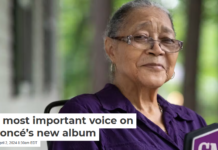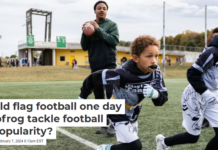
Toby Jenkins, University of South Carolina
While hip-hop has created a lot of good memories, good music and good times, the culture has gifted society much more than just entertainment.
As a researcher who specializes in hip-hop culture, I know that one of hip-hop’s greatest gifts is a certain mindset that focuses on freedom of thought, flexibility and truth-telling. It also includes creativity, authenticity, confidence, braggadocio, uninhibited voice and integrity as those things relate to one’s community and culture.
In order for educators to overcome the challenges of what politicians are turning into an increasingly restrictive teaching environment – particularly with regard to matters of race and racism in American history – I believe the hip-hop mindset has taken on a new sense of relevance in the educational arena.
Many educators feel uncertainty over what they can and can’t say in the classroom. They also want to stay true to themselves. Here, I offer five ways that educators can adopt the hip-hop mindset to confront the challenges they face:
1. Claim your space
When Run-DMC took the stage in the 1980s, they often began their show with Run – one half of the pioneering rap duo – walking on stage and saying to an eager crowd: “We had a whole lot of superstars on this stage here tonight, but I want y’all to know one thing: This is my house. And when I say ‘Who’s house?’ I want y’all to say ‘Run’s house.’”
Through this call-and-response routine, the group claimed every arena in which they performed. Whether you call it posturing, braggadocio or swag, hip-hop culture has long rewarded those who confidently took control of the spaces where they work.
Hip-hop’s longevity is due in large part to this boldness – artists standing firm and fighting back even when they were under attack.
Strong confidence gives artists the guts to be nonconformists, to tell the truth and to try something new – practices that I believe will benefit teachers in the midst of political efforts to control what they say.
2. Form a squad or a crew
From the early days to now, hip-hop artists have always formed squads or crews to perform as emcees or dancers, who often battle to show who has the best lyrics or dance moves.
Early examples include the Rock Steady Crew and New York City Breakers, who famously squared off against one another in an iconic scene from the 1984 hip-hop movie “Beat Street.” https://www.youtube.com/embed/-Xu48tnr4qQ?wmode=transparent&start=0 Breakdancing battle scene from the movie “Beat Street.”
Your squad isn’t just your personal friends – they are your colleagues and comrades in the struggle. They are your trusted village of truth tellers, possibility partners and strategic thinkers. Educators can lean on their squad to help strategize and stay sane.
A squad or crew need not be confined to just one school. Queen Latifah, Monie Love, A Tribe Called Quest and De La Soul – who were either solo acts or individual groups – were all part of an even larger artistic community called Native Tongues.
Just as hip-hop artists are often part of larger groups, educators can similarly build a larger community of support.
Partnering with local nonprofits and community organizations could prove important now more than ever. These organizations can host and facilitate learning experiences that might be prohibited in a classroom. Through these partnerships, students can get free, community-based programs that enable them to have freer discussions that might not be allowed within a public school in a state that restricts what educators can say.
3. Remix
One of the most popular strategies of creating hip-hop music is the remix – where a song’s producer will create a new version of a song, sometimes by borrowing or sampling beats from other songs, changing up the pace, or even introducing new lyrics that weren’t part of the original.
A classic example would be KRS-One’s 1988 song “Still #1.” Whereas the original version was laid back, the “Numero Uno” remix featured a sample of an upbeat Latin jazz song and even opened in Spanish.
Embracing the art of remixing might offer a viable way for educators to respond to efforts to censor what students can read in school or educators can teach in class.
For instance, in school districts or states where certain books or topics have been outlawed, educators can use Books Unbanned – a program in which teens and young adults can access e-books using a national library card. Educators can create a free guide of resources for families that include information on similar programs.
A remix may also be helpful with school funding. Schools at all levels could secure grant and foundational support, which can provide the resources to fund community-based partnerships and the freedom to establish specialized initiatives.
4. Go crate digging
Crate digging is a critical part of the remix. It is the process of sifting through old vinyl records, typically stored in old milk crates or cardboard boxes, to find a long-forgotten song to use in a remix.
Similarly, teachers can turn to the tactics and strategies employed by educators from different eras to see how they dealt with the educational exclusion and erasure of their day. After desegregation, for instance, a new struggle emerged in the 1960s and 1970s to make school lessons more culturally and racially inclusive.
By examining the work of legendary educators like Septima Clark, today’s teachers can uncover ideas and opportunities to re-imagine historical efforts like the Citizenship Schools initiative that Clark developed. These mobile schools – or “rolling schools” as they were called – took learning into community spaces. These schools paved the way for programs like the Freedom Schools that were later developed by the Student Nonviolent Coordinating Committee, or SNCC, and are still in operation today by the Children’s Defense Fund. Communities around the country partner with the Children’s Defense Fund to offer local Freedom Schools.
5. Still keep it real
As a teenage fan of hip-hop in the early 1990s, I remember the phrase “keep it real” – which is an expression of authenticity – as being extremely popular. At the time, it felt like intense pressure to keep it real and to represent your community. I now look back and appreciate that it actually wasn’t pressure, but rather permission to be authentic.
Educators don’t have to champion the new laws and policies that restrict what they can teach – they just have to follow them. But there’s no restriction against “keeping it real” and discussing the new laws and policies as a civics lesson.
So, when the lesson or class is about current events, students could examine various laws being enacted to restrict the teaching of Black history.
Educators may find themselves facing a growing number of challenges from state legislatures as they increasingly invade their classroom spaces and curtail the kind of content they can teach in class. I believe by adopting the hip-hop mindset, educators will be better prepared to do the kind of battle required to prevail on behalf of truth-telling, authenticity, creativity and all the other habits of mind that made hip-hop the defiant and resilient culture that it has become.
Toby Jenkins, Professor of Higher Education, University of South Carolina
This article is republished from The Conversation under a Creative Commons license. Read the original article.




















